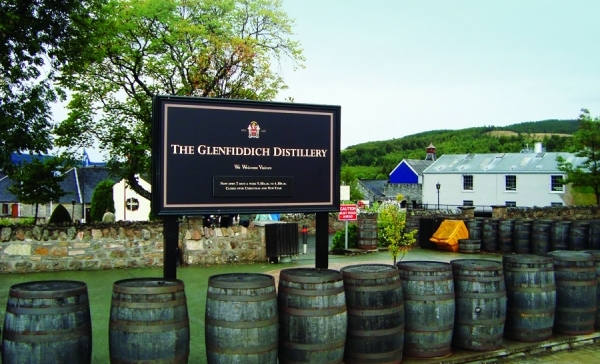
Given the current level of promotional activity for Scotch single malt whisky, you could be forgiven for thinking it was a bigger spirit category than the more traditional blend of malt and grain. Taiwan aside, however, that isn’t actually the case in any world market.
Keen to brush away such myths is David Stewart, the whisky industry’s most senior Master Blender and Malt Master. Addressing this very issue, he says: “Some 90 percent of all sales are still blends, although all the whisky tastings we do tend to be single malts. Very rarely do you go to a blended whisky tasting, which is a bit of a pity. There are a lot of really nice blends out there”.
And he should know. Stewart has worked continuously in the whisky business since 1962, spending all of that time with one employer – William Grant & Sons, the third largest distiller in Scotland. In that time, he has seen the growth of single malt from a small niche product into a drink with a large and devoted worldwide following.
It was actually William Grant & Sons that wrought that change. The first step towards establishing single malt whisky as an international drink category was taken in 1963 when the company began promoting its Glenfiddich single malt to whisky drinkers in England. Some 10 years after its launch, the rest of the whisky industry caught on to its success, with a string of other single malts – including Glenmorangie, Macallan and Glenlivet – all gradually introduced.

Recently, Stewart was in Hong Kong as a judge in an international wine and spirits competition. It was here that he got a chance to catch up with some of the more recent additions to the whisky cannon.
Addressing his sampling experiences, he said: “Some of the New World whiskies were quite interesting. I’d seen some of them before – the Kavalans and Mackmyra from Sweden – and some of the Australian whiskies. The quality is really very good, but Scotch has still got that history, heritage and tradition behind it.”
It is also Scotland, he points out, that has been the source of most of the innovations that have refined and diversified the spirit over the year, with a number of those innovations being his own.
Along with Bill Lumsden of Glenmorangie, he is credited with the first successful experiments in the use of cask finishes, a process that gives matured whisky some extra barrel time in casks that have previously contained wines or other spirits. This can gently modify the spirit’s flavour and aromas without changing its essential character.

“Overall, I’d still say that the world’s favourite whisky remains – without a doubt – Scotch whisky”
Recalling the early days of such experimentation, he says: “Back in the 1980s, when we did the Balvenie sherry finishes, they weren’t called finishes at all. We didn’t tell anyone what we did. I was then asked to create a new range of whiskies to celebrate the centenary of Balvenie in 1992. We decided to take the Balvenie Classic and call it Balvenie Doublewood. It was then that we started telling people what we had done.
“The process involved 16 years in American oak, then being finished in sherry wood for a number of months. Later in the 1990s, other companies started to come out with different finishes – sherry, port and rum, red wines, white wines, peated casks…”
Prior to the introduction of cask finishes, most distillers had simply offered one spirit at different ages. At the time, the number of years in the barrel was the sole determinant of price. Now we have a seemingly infinite number of cask finishes – and an increasing number of whiskies that carry no age statement at all.
“Once you get into Scotch, there’s a big journey ahead of you. There are 110 different distilleries in Scotland, and they’re all producing different tastes and different styles of whisky. We’ve got 15 different Balvenies, at least, out there. Glenfiddich and Macallan have something similar or more. In all, there are more than 1,000 different whiskies to try of different ages and finishes.
“There’s also a great variety of flavours – from the sweet Speysides, to the lighter Highlands, to the smoky, peaty Island whiskies. There’s a huge variety for consumers to try, which can’t be said of many other spirits.”

Today, although semi-retired, he remains Malt Master at Balvenie, one of only about half a dozen distilleries in Scotland with its own “malting floor”, an area where the barley – from which the spirit is later distilled – germinates.
Having clearly seen a number of changes over his long history with the distillery, he says: “We have grown hugely over the last 20 years and the range has grown hugely as well. A lot of people know about Balvenie now. It’s quite well known in Hong Kong and its biggest market in the world – after the US – is Taiwan.”
Balvenie’s single malt production, however, is dwarfed by that of Girvan, a Grant’s distillery that doesn’t even bottle spirit under its own name. The grain whisky distilled there is combined with malt whisky for blends, some bottled by Grant’s and others by its competitors.
Although Glenfiddich was briefly overtaken by The Glenlivet as the world’s number one selling single malt Scotch whisky, according to Stewart it has recently taken back the lead. For his own part, though, he is happy steering a smaller ship within the same fleet.
He says: “It’s not always great to be number one. Sometimes consumers think you are too common because you are so well known. The quality is there with Glenfiddich, though, and people do still enjoy it. Overall, I’d still say that the world’s favourite whisky remains, without a doubt, Scotch whisky.”
Without a doubt, he also has view as to just which Scotch whisky remains the world’s favourite…



